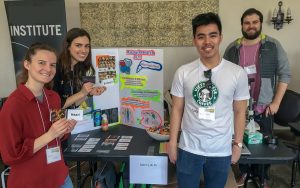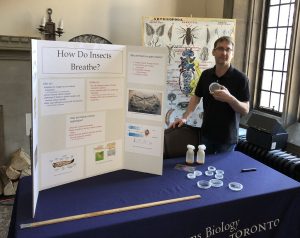Cell & Systems Biology was proud to support this year’s Let’s Talk Science Challenge event for Grade 6-8 students at Hart House on May 6th. We were also glad to present our work to the students. There were about 120 students at the event who visited displays from Professor Garside of the teaching stream and the lab of Professor Fernandez-Gonzalez of the research stream.
Professor Garside conceived and presented an engaging activity on Insect Respiration. We even pulled a Zoology teaching chart out of the Archives, which gave us a large diagram of insect anatomy to show the students.
We were fortunate that one of the live insects we brought for the exhibit began molting half an hour before students arrived. The insects were going through a growth spurt, just like the students, but insects don’t have skin that stretches; they had to break out of their rigid exoskeleton. Lots of kids were fascinated as they watched our fresh-bodied cockroach wriggle to shed its crunchy skin.
This gave Professor Garside (and his assistant Dr Neil Macpherson) a great prompt to explain that insects can’t expand their bodies to breathe like us because of their rigid exoskeleton. He asked the students to speculate on how insects breathe if they don’t have lungs, and helped them to identify spiracles, valved pores in the side of the insect body that open to allow air to diffuse throughout the body through small tubes and sacs.
He also showed insect fossils from the Carboniferous period that had bodies the size of a seagull; some kids theorized that only the high oxygen levels of the Carboniferous allowed insects to take in enough oxygen to grow to that size. We inspired the students to imagine a world with insects as large as birds.

Professor Fernandez-Gonzalez’ students, Katheryn, Gordana, Gary and Chris participated in the Let’s Talk Science Challenge event to teach the children about fruit flies. They showed kids how they use fluorescent proteins to “Light up the Fly”. Through a fun matching game, they taught them how we can study disease and development in different tissues by using cool techniques to make proteins “glow”. One of their most popular activities was showing kids a beating heart in a living fly using fluorescent proteins that are specifically localized in the heart. We know that none of these kids will ever look at a fruit fly the same way again.
Overall, we had a great time sharing our teaching and research with this young audience and we hope to have inspired some future scientists along the way!

